OK. I’ll admit it. I do have a soft spot for older women. My grandmother, my mother, Shejokhalamma, Chotokhalamma, Chotomami, Sufia Khala (poet Sufia Kamal), Didi (Mahasweta Devi) were all pretty special. All in their eighties or so. I can’t be entirely to blame though. When a woman says, “I’ve been waiting for you all day. I’ll wait all night. You must come.” How can one say no? Especially if it’s a woman you haven’t even met. And Fatima Meer was some woman.
It was a long route from Mexico City. I had stopovers in Frankfurt, London and Dubai, but it was Johannesburg I was headed for. There had been an initial panic when the assistant of Professor Yunus, Lamiya told me that the meet and greet with Nelson Mandela had been scheduled for the 8th. There was no way I could make it over from Mexico by then, but my good luck held out. Madiba rescheduled for the 10th! Arriving on the 9th evening, I headed off to Kensington to the home of Wilson and Rayhana. Wilson had been at Pathshala for two years, and they had kindly offered to put me up.
The Lamborghini, two Porches, a Ferrari, a Bentley and a Rolls that I saw parked next to each other in Mandela Square, spoke of the huge inequalities that still had to be dealt with in South Africa. Watching “Jerusalem – The Promised Land” on the flight in, reminded me of the post apartheid expectations that needed to be matched by ground realities. The British had lured in Indians with the Dick Whittington story of streets paved with gold. Now the youth in Hillbrow wanted to see the gold, and they wanted it now. As Mandela had said upon release, the long walk to freedom had only begun. Lucky Kunene wanted short cuts.
This was no ordinary assignment, and I knew there was not going to be a second chance. Checking out with Lamiya what the drill was for the 10th, I charged my batteries, cleaned my lenses, emptied my memory cards and double checked all my equipment. There was too much at stake. Access to Madiba was always going to be difficult. Robin Comley, the picture editor of the Times had only obtained permission for her photographer to be part of the pool. The foundation would vet the low res images, and select which ones would be released. The pictures were to go out in the foundation’s name. There was no chance of an exclusive session. I was privileged and very much the exception.
Yunus bhai had put in a strong recommendation for me. The fact that I had written about Dr. Yunus and had historical pictures of Grameen, had helped. My photograph filled the front page, and my article was the key feature of the foundation’s brochure for the 7th annual lecture. So while I was theoretically only allowed limited access to Madiba’s room in the Mandela Foundation, I ended up being the first one to go in and the last one to leave.
To be face to face with the legend was stupendous in itself, but he looked frail, and I found myself asking why we were making this wonderful man put up with this parade. Madiba and his wife Graca were waiting inside. Yunus Bhai, Lamiya, Kamal Bhai and I made up the Bangladesh delegation. Three others from the international film crew, who were not allowed to film, also came in. The official photographer and cameraperson made another two, and of course, the officials of the foundation joined.
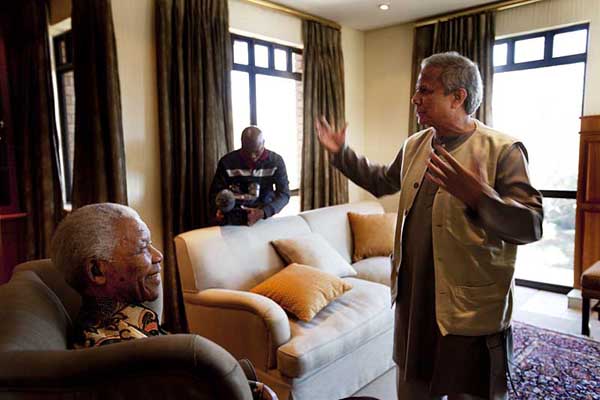
Shaking hands, posing for pictures, repeated shakes for the camera, one sided conversations continued. I had photographed royalty and heads of state before. This was typical of a ‘meet and greet’, but though I felt uncomfortable, I also wanted to be selfish. I wanted to talk to him, to soak up his presence, even an urge to be photographed with him. But as a photographer I needed to snap out of my reverie. Yunus meeting Mandela was of huge significance to Bangladesh. A few functional shots, of the two meeting, shaking hands, a short video clip. I had ticked off my check list. Now I wanted the picture I had come for. Madiba as I had pictured him. The statesman, the leader, the rebel, the visionary.
There was only one part of the room where the light was just right. Yunus Bhai was in front of me. I could hardly move him out of the way, and there was no question of shifting Madiba. So I prefocused on Madiba, and waited for a gap to emerge. One frame, another, he slowly turned, looked at me and smiled!
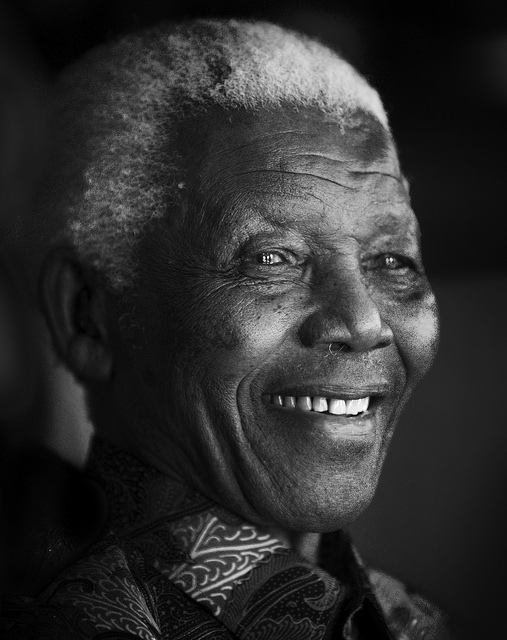
We had made contact the way a photographer makes with a subject. We were doing this together. I remembered Sasa talking of how Madiba, in an official ceremony, had shortened his speech, so that he and the other photographers soaking in the rain, could go on home. More importantly, I remember Zapiro talking of how Madiba had called him after his critical cartoon of the ‘slipping halo’. He was worried that he had offended the most powerful man in the country. Instead, the president had praised him for his work. As for the criticism? “But that’s your job”, he had replied. I had been pleasantly surprised to see the ‘offending’ cartoon, displayed in both the Mandela Foundation and at the exhibition in the Apartheid Museum. My mind was wandering, but the minders were waiting to usher me out. I took one longing look at my hero, and left.
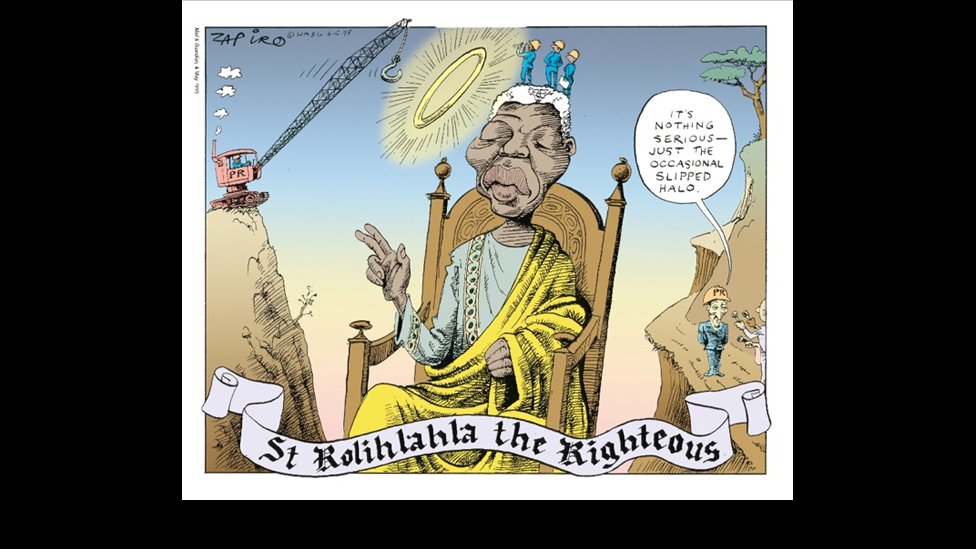
The City Hall in Johannesburg was packed with the glitterati. The vice president of South Africa, Professor Yunus, Achmat Dangor, the CEO and Professor Jakes Gerwel, the chairman of the foundation, were all on stage. I was uncomfortable sitting in the front row, knowing Winnie Mandela, the rest of the Mandela family, Oliver Tambo’s daughter, Graca Machel’s daughter, members of the cabinet, the Bangladeshi High Commissioner were all behind us.
I didn’t stay in my seat long. I needed to search out the best angles, find the right light. But this was one situation where I could not be disrespectful. Sello Hatang, the information and communication officer nodded to me, letting me know when Madiba was about to enter. Officially I was not allowed this space, but I could read the signals. They trusted me and were going to turn a blind eye. I would be allowed to go where I wanted.
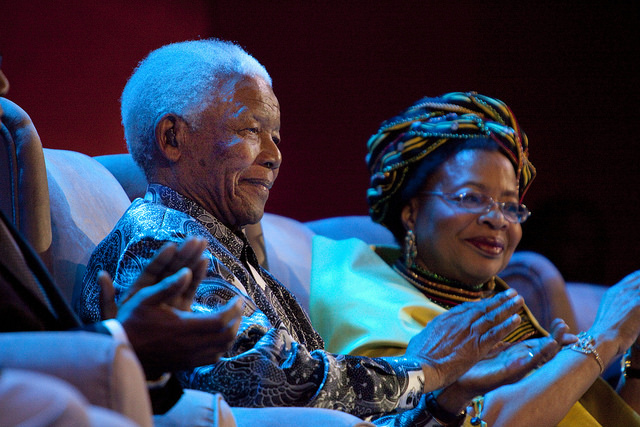
The crowd rose like a wave, as he entered, helped along by Graca Machel, but walking with just the help of a stick. He looked less frail, made more eye contact, had small conversations. The crowd was there to see him. The great man responded.
The haunting voice of Zolani Mkiva set the scene. Professor Yunus, ad-libbed his hour long lecture. The audience was spellbound. Gill Marcus, the deputy governor of the reserve bank, wept. It was a different Bangladesh that South Africa was seeing. As the crowd mingled at the end of the talk, I went looking for Sello. I had promised my students at Pathshala that I would ask for a message from Madiba for their first book. I knew it was too much of an ask. Winnie walking past, squeezed my arm and gave me a tiny pinch. She had enjoyed my capers as I had wandered down the aisles looking for the best angles.
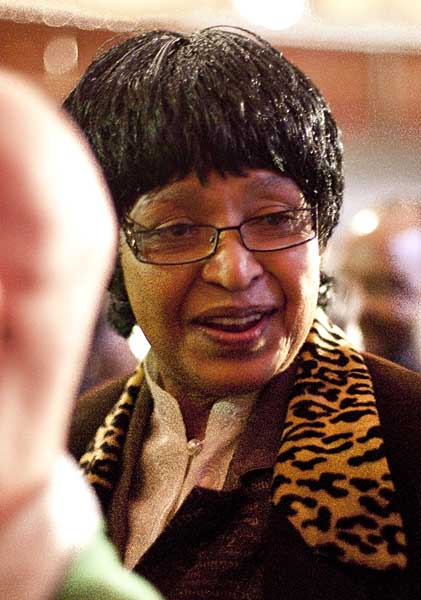
I had meant to take the morning flight to Durban to see Fatima Meer. Vinay Lal from UCLA and his friend Goolam Vahed, had given me the contact details. I had even rung to let her know that I would be coming over. The day had gone on captioning pictures, uploading files, informing clients. I had rung Maarten at World Press Photo, checking up on phone numbers for photo editor friends. “What was it like with Madiba?” he had asked. “The pictures came out well” I had said, “but it would have been sufficient for me, even if I hadn’t taken any pictures. Just being around him would have been enough.” “I thought so too” Maarten had said. “I know you as an activist”. I reluctantly rang the freedom fighter Fatima Meer to tell her I wouldn’t be able to make it. It was too late to call on her. The woman who had spent time in prison with Winnie, and along with her husband Ismail, had been one of the closest friends of Madiba, had other ideas. Quickly searching the Internet for the cheapest flight, and taking along the minimum equipment, I got into Wilson?s car. There was no time to charge batteries or empty cards. but it would be OK, I thought. After all, I’d only have a few minutes with her.
It took a while to find 148 Burnwood Road in Durban. As I went up the stairs to see this woman wrapped up in her easy chair I thought of the fiery activist, whom the apartheid government had tried to assassinate. I remembered the irony of Nelson Mandela, Fatima Meer and all other members of the ANC, having been listed as “terrorists” in the US, even until last July. The apartheid government, which had openly conducted so many targeted assassinations, had never been on that list.
“Have you eaten” was her first question. I remembered I had entered an Asian home. A stroke had left her left side paralysed. “Lucky it was the left side,” she said. “I can still work.” She then got busy arranging for a place for me to sleep. The corner room was ready, towels, soap, fresh blankets, had all been put in place. I was happy I didn’t have to find a hotel that late at night. I was hesitant to ask if I could record what we were saying. I needn’t have worried. Gandhi, slavery, Mandela, the movement, her mind was a repository of South African history. When I heard that Mandela had stayed in this house upon leaving Robben Island, I had asked which room he had stayed in. Sensing my reasons, she said, Desmond Tutu, Oliver Tambo, Walter Sisulu, had all slept in the middle room. Calling over her night nurse, she quickly instructed. “Fix that room for him. He is going to sleep there.” I was going to sleep on the bed that Mandela used to sleep in!
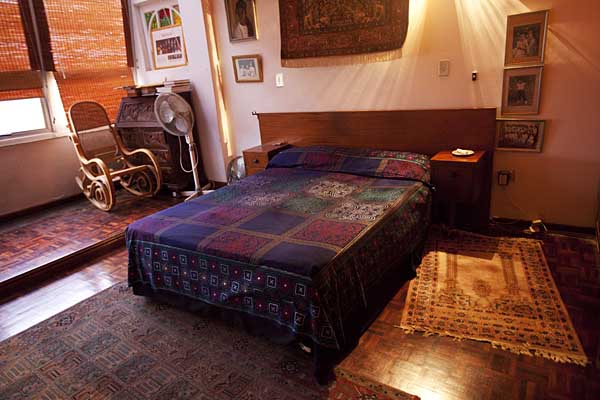
She talked of the Koran that Dada Abdullah had given Gandhi when he sent him over to South Africa. Of the Sura from the Koran which he had read when thrown off the train. Of how it had inspired him to resist. She talked of the house being surrounded by fire, and they being shot at. About how her husband Ismail, even while in jail during the treason trial, had helped her in carrying on the resistance. Thinking she might be tiring, I suggested we have a break. “Let’s get on with the recording” she said. We talked of the ‘bronze giant’ Mandela chatting her up and teasing her. But also of wanting the couple’s opinion about Winnie, before the new relationship had formed.
She had loved the ‘black pimpernel’ in the 1960s. She loved him still.
She talked of establishing the Women’s League for Durban Districts, and rebuilding alliances between Africans and Indians following the race riots of 1949. She spoke bitterly of how the riots had been instigated by the whites, in retaliation for the Gandhi inspired resistance by the Indian community. But she had questions too about Gandhi, and Madiba, and the present government. Gandhi had been too British initially for her liking. Madiba’s handing over power to Mbeke, was a misjudgment. “He failed to build the second tier of leadership.” She spoke of the tyranny of the ANC, the party she had helped to build.
I soon ran out of memory cards. I did have my computer with me, so was able to download the movies to make space. Then I ran out of batteries. I had woefully miscalculated the vitality of this eighty-plus woman. I still needed portraits, so I would have to leave it till the morning, hoping the batteries recovered sufficiently for me to take a few shots. Fatima was more than willing. It was 3 in the morning. My flight was at 8:40. I woke up just before sunrise, and quickly packed. There was barely enough light to photograph the room and the bed. I needed to conserve battery for the portraits. Fatima knocked on my door. As I went over to her side and asked her if I could take the photographs, she simply said “Let me do my hair first”. The hair was done, the photographer was called. She had put on her sunglasses. I was happy to photograph her with her glasses, but also wanted pictures of the way I remembered her. The animated face recounting those wonderful tales. “Will you smile for me” I had asked. “Well I haven’t put on my dentures,” she said, but smiled anyway. This woman had certainly won my heart.
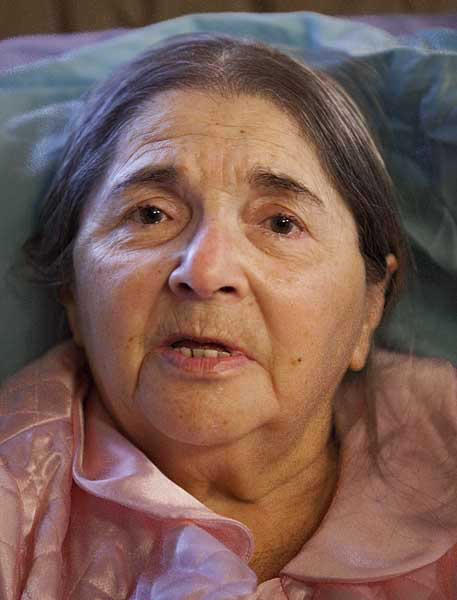
There had been a call for each citizen of the world to provide 67 minutes to commemorate the 67 years of service that Mandela had given to South Africa and the world. “This recording will be our 67 minutes. This story needed to be told,” were Fatima’s parting words.
As her trusted taxi driver, Babu dropped me to the airport, I remembered Fatima talking of how prison had robbed the nation of the best years of their greatest leader. I remembered Madiba, delicate and frail. This giant of a man would be leaving us at a time when we needed him the most. He had fought against white domination, and he had fought against black domination. He had a dream of a democratic and free society. A dream he had been prepared to die for.? It is for those of us who live on, to realise that dream. I now knew why Fatima had wanted the story to be told.
Happy Birthday Madiba. You built the road to freedom. We need the courage to walk it.
18th July 2009
Dhaka.

Shahidul,
What an amazing series of encounters! Many thanks for letting us bask in the glow of your meetings and passing along the inspiration from Mandela, Meer and Yunus. The Mandela portrait is absolutely extraordinary; bravo my friend. I look forward to reading more about your interview with Meer; it sounds like a rare insight into the history of South Africa. Perhaps it could be published in South Africa and elsewhere?
All warmest wishes,
Richard Covington
Priyo Shaidul Bhai,
This is a great story to read and bring back so many memries of Mendela. Thanks for sharing. How envious it is you sleep in Mandela’s bed. Just kidding.
Thank you and always be alive mentally.
The very best wishes.
Asoke Chakravarty
Dear Shahidul
This mussing was inspiring and interesting…..
Best of wishes
Panduka
What an experience. Gave me goose bumps just reading about it. Must have been fantastic. Lovely pictures too.
What a moment…….. two legend together,Nobel Peace Prize Laureate Professor Muhammad Yunus, the founder of Grameen Bank meets Nobel Peace Prize Laureate, former president of South Africa and leader of the ANC,Nelson Mandela.
That was a truly amazing and inspirational article. Am super jealous of you but also feel very privileged that you shared your experience and pictures with us.
Buckets of luv and affection
Ruksana
Dear Shahidul Bhai,
It was great to read such a lucid description of memorable events!
I am a neighbour, living in 45B (Next door to Drik), Apptt # 602. Feel privileged living so close to you!
Lets meet up. You choose the date and time.
Best regards and congrats on all the achievements.
Wali
Dear cha cha,
What a wondrful conglomeration!!!! Thanks for letting us know.
Regards,
Rafiq Azam
Shahidul Bhai
Wonderful experiences and photos, thank you. I saw the great man speak in Trafalgar Square a few years back, was wonderful to see him even from a great distance. Bravo.
Best wishes
Adam
Good evining , Shahidul Bhai .all photo is good .
Thanks .
Ali hossain ,
Bangladesh
those eyes, that smile, speak volumes,
what a gift!
many thanks Shahidul,
Rosa
Dear Shahidul Bhai,
I don’t know what you excel more at – the words or the images. You had a once-in-a-lifetime encounter & experience and you have etched it in our memories as well. Lucid, simple, thoughtful and your streaks of activist-days comes through like light through the clouds. Bravo. Superb image and I just loved your closing “Happy Birthday Madiba. You built the road to freedom. We need the courage to walk it.”
~ Suchit
Mumbai
Excellent piece. Thanks!
Shahidul, these are incredible photographs. Would it be possible for you to drop me a line at vanessak@assocmags.co.za? we’re doing a feature on Madiba at the moment and might be interested in publishing some of your work.
Dear Shahidul Bhai,
You are renowned and the works are also renowned, this wonderful piece is remarkable and the pictures truly memorable. Your contribution makes us rich.
Syed G. Qadir, Tourism Professional and Social worker
Its amazing and Inspiring, I can travel all those places through your write-ups. and the photos are incredible.
Homaed Ishaque
Traveler
Very touching narration and photo’s.
great article!!
Thanks Arnaz. Sorry I’ve been slow to respond. We’ve been inundated here with all sort of problems and the election violence hasn’t helped.
Thanks Arnaz. Some day I’ll get down to writing the many other stories behind that story
It was lovely to revisit this article again. Your magic with words and pictures enables us to experience poignant moments with you.
Thanks Ruksana. We had a huge print outside the gallery for his birthday, which we kept up. It became more significant with his passing away. Love, Shahidul
Very inspiring post. It would be such an honor to have taken photos and just talked with this icon.
Thanks. As you can imagine, it was one of the moments that will remain special for me. Sadly Fatema Meer passed away soon after.